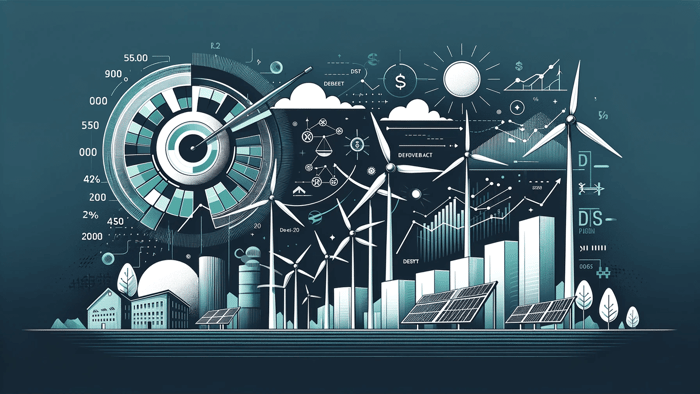Renewable energy project finance modeling is a financial analysis technique used to evaluate the feasibility and profitability of renewable energy projects such as wind, solar, hydro, geothermal, and biomass.
The modeling involves creating a financial model that calculates the cash flows, returns, and other financial metrics of the project, typically over a period of 20-40 years. The model considers factors such as capital expenditures, operating costs, debt financing, tax incentives, and revenue streams from the sale of energy or guarantees of origin (GoOs).
The purpose of renewable energy project finance modeling is to help project developers, investors, and lenders assess the economic viability of a renewable energy project and to identify any potential financial risks or uncertainties that may impact the project's financial performance. The model can also be used to test different scenarios and assumptions to optimize the project's financial structure and improve its overall profitability.
What is project finance?
Project finance, or more specifically renewable energy project finance, is a financing structure that provides funding for a specific project, typically a large-scale infrastructure or capital-intensive project. In project finance, the project itself is used as collateral for the financing rather than relying on the creditworthiness of the sponsor or the company behind the project. This means that the lenders and investors look to the future cash flows generated by the project as the source of repayment rather than relying on the sponsor's balance sheet.
Project finance is typically used for large, complex projects that require significant capital investment, such as building a renewable energy power plant, a mine, a pipeline, or a telecommunications network. The main objective of renewable energy project finance is to allocate risk to minimize the impact on the sponsors and lenders while providing a stable source of financing for the project. Renewable energy project finance can help to reduce the risk for lenders and investors, align the interests of all parties involved, increase transparency and accountability, and support the development of infrastructure and capital-intensive projects.
What role does financial modeling play in project finance?
The purpose of financial modeling in project finance is to determine the feasibility of a project and its expected financial performance. A financial model is a tool that helps to simulate the future financial performance of a project, taking into account various factors such as revenues, operational expenditures, debt financing, taxes, and other variables. The model is based on a set of assumptions and provides an estimate of the expected cash flows, returns, and other key investment metrics over the life of the project.

Project finance in a renewable energy-related context.
Renewable energy project finance refers to the financing structure used for financing renewable energy projects, such as wind farms, solar parks, geothermal plants, and hydropower plants. The main principle behind project finance for renewable energy is the same as for any other project finance: lenders and investors look to the future cash flows generated by the project as the source of repayment rather than relying on the creditworthiness of the project sponsor or the company.
In the context of renewable energy, project finance can play a crucial role in promoting the growth of the renewable energy sector by providing a stable source of funding for the development and construction of renewable energy projects. The benefits of project finance for renewable energy include:
1. Lower risk: Project finance can reduce the risk for lenders and investors by allocating risk to the parties best positioned to manage it and ensuring that the project is structured in a way that minimizes risk.
2. Better alignment of interests: Project finance can create a more aligned relationship between lenders and project sponsors, as both parties focus on the project's success.
3. Increased transparency: Project finance can help to increase transparency and accountability by clearly defining the responsibilities of all parties involved and creating a clear structure for monitoring the performance of the project.
4. Increased competitiveness: Project finance can make renewable energy projects more competitive by reducing the cost of capital and improving the terms and conditions of financing.
5. Increased project viability: Project finance can increase the viability of renewable energy projects by providing a stable source of funding and reducing the financial risk involved.
Enhance the decision-making process of your organization with a comprehensive financial model dashboard.

If you're looking to invest in renewable energy, you need a comprehensive financial model dashboard that summarizes all the key investment metrics relevant to your decision-making process.
This financial model dashboard for renewable energy investments is designed to help you make informed investment decisions with ease. It includes a detailed breakdown of the project's capital structure, allowing you to understand the financing mix of the project and the risks associated with each layer of the capital stack.
The dashboard also considers critical investment metrics such as IRR and NPV on both a levered and unlevered basis, giving you a complete picture of the project's profitability.
In addition to these essential investment ratios and multiples, the dashboard details the payback periods, CFADS/EV, Revenue/EV, EV/MWp, and EV/MWh. These metrics are crucial in evaluating the financial viability of the project and determining its potential for generating returns over the long term.
The dashboard also features eye-catching charts that provide a visual representation of the project's cash flow generation over its entire asset lifetime. This feature will give you valuable insights into the project's cash flow patterns and help you make informed investment decisions.
With all these critical investment metrics and data points in one place, this financial model dashboard is the ultimate tool for renewable energy investment decision-makers.
How to build a project finance model from scratch?
Do you want to learn how to build a project finance model from scratch? Then check out the Advanced Renewable Energy Financial Modeling course.
Renewables Valuation Institute has been listed among the 15 Best Financial Modeling Blogs and Websites.
Renewables Valuation Analyst Program
The Renewables Valuation Analyst Program offers a focused and practical approach to mastering financial modeling for renewable energy projects. This specialized program is designed for those eager to develop their skills in building financial models from scratch, explicitly tailored to the renewables sector.
Key Highlights of the Program
- Core Focus on Financial Modeling: Learn the art of constructing detailed and robust financial models for renewable energy projects, starting from the ground up.
- Tailored to Renewable Energy: The curriculum is specifically designed around the nuances and specifics of renewable energy, including solar, wind, and other emerging technologies.
- Hands-On Learning Experience: Engage in practical exercises and real-world case studies that reinforce theoretical knowledge with practical application.
Benefits of Enrolling
- Skill Development: Gain proficiency in a critical skill set that is highly sought after in the renewable energy industry.
- Career Advancement: Elevate your professional value and open new career opportunities in a rapidly growing field.
- Industry Relevance: Stay ahead in an industry that increasingly relies on accurate and sophisticated financial modeling for decision-making and investment.
Push your career to the next level!
For professionals aiming to excel in renewable energy finance, the Renewables Valuation Analyst Program is an invaluable resource. It’s more than just a course; it’s a career investment, providing you with the tools and knowledge to build effective financial models specifically for the renewable energy sector. Join us to enhance your expertise and become a proficient financial modeler in the dynamic world of renewable energy.






